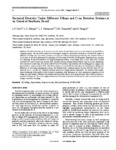Use este identificador para citar ou linkar para este item:
http://www.alice.cnptia.embrapa.br/alice/handle/doc/968218Registro completo de metadados
| Campo DC | Valor | Idioma |
|---|---|---|
| dc.contributor.author | SILVA, A. P. | pt_BR |
| dc.contributor.author | BABUJIA, L. S. | pt_BR |
| dc.contributor.author | MATSUMOTO, M. F. | pt_BR |
| dc.contributor.author | GUIMARÃES, M. F. | pt_BR |
| dc.contributor.author | HUNGRIA, M. | pt_BR |
| dc.date.accessioned | 2014-03-07T23:23:05Z | - |
| dc.date.available | 2014-03-07T23:23:05Z | - |
| dc.date.created | 2013-10-09 | pt_BR |
| dc.date.issued | 2013 | pt_BR |
| dc.identifier.citation | The Open Agriculture Journal, v. 7, Suppl 1-M6, p. 40-47, 2013. | pt_BR |
| dc.identifier.uri | http://www.alice.cnptia.embrapa.br/alice/handle/doc/968218 | pt_BR |
| dc.description | Microbial diversity can be used to assess the impact of agricultural practices on the long-term sustainability of cropping systems. The aim of this study was to investigate changes in soil bacterial diversity as a result of the impact of different soil tillage and crop rotation systems in an oxisol of southern Brazil. Bacterial diversity was examined in the 0-10 cm layer in two field experiments by analyzing soil DNA using 16S rDNA-DGGE profiles. Experiment one consisted of a long-term 26-year trial with four soil tillage management systems: (1) no-tillage (NT), (2) disc plow (DP), (3) field cultivator (FC), and (4) heavy-disc harrow (DH), all under soybean (summer)/wheat (winter) crop succession. Experiment two consisted of a short-term 10-year trial with DP and NT and three crop rotations (CR) including grasses, legumes and green manures. Cluster analysis of the 16S rDNA sequences revealed that the main effect on clustering was attributed to differences in soil tillage management systems. The Shannon index confirmed greater bacterial diversity under NT, followed by the FC, DH and DP. Therefore, diversity decreased as tillage practices intensified. The evenness index demonstrated uniformity of the profiles of the bacterial communities, with dominance of a few communities, regardless of soil tillage and crop rotation. Different crop rotations had only minor effects on bacterial diversity, what could be related to a previous fallow period. The results suggest that bacterial diversity analyzed by DGGE may be useful as bioindicator of the changes caused by soil tillage. | pt_BR |
| dc.language.iso | eng | eng |
| dc.rights | openAccess | eng |
| dc.title | Bacterial diversity under different tillage and crop rotation systems in an oxisol of Southern Brazil. | pt_BR |
| dc.type | Artigo de periódico | pt_BR |
| dc.date.updated | 2014-03-07T23:23:05Z | pt_BR |
| dc.subject.thesagro | Solo | pt_BR |
| riaa.ainfo.id | 968218 | pt_BR |
| riaa.ainfo.lastupdate | 2014-03-07 | pt_BR |
| dc.contributor.institution | UEL; UEM; UENP; UEL; MARIANGELA HUNGRIA DA CUNHA, CNPSO. | pt_BR |
| Aparece nas coleções: | Artigo em periódico indexado (CNPSO)  | |
Arquivos associados a este item:
| Arquivo | Descrição | Tamanho | Formato | |
|---|---|---|---|---|
| bacterialdiversity.pdf | 1,4 MB | Adobe PDF |  Visualizar/Abrir |









